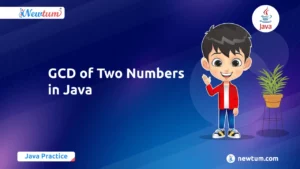In this blog, we’ll learn about the ISBN Number in Java and other related topics. So let’s start with the blog on ISBN Number in Java.
What is ISBN Number in Java?
The ISBN (International Standard Book Number) is a unique identifier assigned to each published book. It is a 10 or 13-digit number that helps in identifying and tracking books in the book publishing industry. In Java, working with ISBN numbers involves tasks such as validating the correctness of an ISBN, converting between ISBN formats, generating random ISBN numbers, and more. By using Java programming, developers can implement algorithms and functions to manipulate and work with ISBN numbers efficiently.
Example of ISBN Number in Java
Check the below example of ISBN number in Java for a better understanding:
Example 1: 9780141441146
Sum = (11) + (24) + (31) + (44) + (51) + (64) + (71) + (81) + (94) + (106) + (119) + (127)
then, Sum = 1 + 8 + 3 + 16 + 5 + 24 + 7 + 8 + 36 + 60 + 99 + 84
Sum = 351
rem = 351 % 11
rem = 6 ≠ 0
Number 9780141441146 is not a legal ISBN because the remainder is not equal to 0.
Example 2: 0316015849
Sum = (10) + (24) + (39) + (48) + (55) + (61) + (75) + (88) + (94) + (109)
then, Sum = 0 + 8 + 27 + 32 + 25 + 6 + 35 + 64 + 36 + 90
Sum = 323
rem = 323 % 11
rem = 9 ≠ 0
Number 0316015849 is not a legal ISBN because the remainder is not equal to 0.
Also, learn about Evil Number in Java, Now!
Example 3: 0060935464
Sum = (10) + (24) + (36) + (45) + (54) + (69) + (73) + (85) + (94) + (106)
then, Sum = 0 + 8 + 18 + 20 + 20 + 54 + 21 + 40 + 36 + 60
Sum = 277
rem = 277 % 11
rem = 0
Number 0060935464 is a legal ISBN because the remainder is equal to 0.
Remember, an ISBN (International Standard Book Number) consists of either 10 or 13 digits and is used to uniquely identify books. Moreover to determine if an ISBN is legal, you need to calculate the sum of the products of each digit with its corresponding position, divide the sum by 11, and check if the remainder is 0.
Get complete Java Programming Exercises and Solutions here!
Java Program to check whether a given number is an ISBN Number or not in Java
//import required classes and packages
import java.util.*;
import java.io.*;
import java.util.Scanner;
//create ISBNNumberExample class to check whether the given number is a valid ISBN or not
class ISBNNumEx {
static boolean checkISBNNum(long num)
{
int sum = 0;
int i, t, intNumber, dNumber;
String strNumber;
strNumber = ""+num;
if (strNumber.length() != 10) {
return false;
}
for (i = 0; i < strNumber.length(); i++) {
intNumber = Integer.parseInt(strNumber.substring(i, i+1));
dNumber = i + 1;
t = dNumber * intNumber;
sum = sum + t;
}
// check whether the sum is divisible by 11 or not
if ((sum % 11) == 0) {
return true;
}
return false;
}
// main() method start
public static void main(String args[])
{
long n1, n2;
try {
//create BufferedReader class object to get input from user
InputStreamReader in = new InputStreamReader(System.in);
BufferedReader br = new BufferedReader(in);
//show custom message
System.out.println("Enter first 10 digit ISBN number");
//store user entered value into variable n1
n1 = Long.parseLong(br.readLine());
if (checkISBNNum(n1))
System.out.println(n1 + " is a valid ISBN number");
else
System.out.println(n1 + " is not a valid ISBN number");
}catch(java.lang.Exception e) {
System.out.println("Error while reading the data.");
}
}
}
Explanation of the code:
The Java code provided is intended to validate a 10-digit ISBN (International Standard Book Number). It starts by importing the classes and packages required for input/output operations. Finally the code defines the ISBNNumEx class, which contains the primary logic for validating the ISBN number.
The program checks the checkISBNNum method to see if the ISBN is exactly 10 digits long. If not, it returns false immediately because a valid ISBN must have exactly 10 numbers. The code iterates over each digit of the ISBN, calculating the product of the digit and its corresponding position, and adding the sum of these products.
Next after calculating the total, the program checks to see if it is divisible by 11. If the sum is divisible by 11 (i.e., the remainder is 0), the method returns true, indicating that the ISBN is valid. Otherwise, it returns false. The program prompts the user to enter a 10-digit ISBN number in the main method, then reads the input with BufferedReader and stores it in the n1 variable. Finally, the checkISBNNum method is invoked with n1 as an argument, and a message is displayed indicating whether or not the ISBN is valid.
This code provides a simple Java implementation for validating a 10-digit ISBN number.
Output:
Enter first 10 digit ISBN number1259060977
1259060977 is a valid ISBN numberKnow the Fibonacci series in Java here!
Tips & Tricks for ISBN Numbers
10 Tips and Tricks for Effective Implementation of ISBN Numbers in Java
- Recognize the ISBN structure:
Learn about the structure and components of ISBN numbers.
Understand the distinction between 10-digit and 13-digit ISBN formats.
- Use the following data types:
To store ISBN numbers in your Java program, select the appropriate data type.
Consider using a string or a custom data type designed specifically for ISBNs.
- Apply ISBN validation:
Create a strong validation mechanism to ensure that the ISBN numbers entered or processed by your program are correct. In addition to ensure that checksums and formatting are correct, use a validation algorithm or library.
- Handle a variety of ISBN formats:
Consider the possibility of dealing with both 10-digit and 13-digit ISBNs. Implement methods or functions that can handle format conversion.
- Use libraries or APIs:
Use existing Java libraries or APIs that provide ISBN-related functionality.
These libraries can assist with ISBN number validation, conversion, and other operations.
- Enhance efficiency:
To handle ISBN-related operations, use efficient algorithms and data structures, especially when working with large datasets. When performing repetitive ISBN operations, consider using caching or memoization techniques to improve performance.
- Handle exceptions with grace:
To gracefully handle errors or invalid ISBN numbers, use exception-handling mechanisms. Provide meaningful error messages or prompts to help users correct input errors.
- Implement search and lookup functionality:
Create methods or functions for searching for books based on their ISBN numbers. Using ISBN as a key, use APIs or databases to retrieve book information.
- Maintain data integrity:
When working with ISBNs, implement mechanisms to prevent data duplication or inconsistency. To maintain data integrity, use appropriate database constraints or unique key constraints.
- Document and comment on your code:
Document your implementation strategy, algorithms, and any custom logic related to ISBN handling. Add comments to your code to improve readability and assist future developers who may work with the codebase.
In conclusion, Java developers can effectively handle ISBN numbers by understanding their structure, data types, and efficient algorithms. By leveraging libraries and APIs, they can simplify implementation, optimize performance, handle exceptions gracefully, and implement search and lookup functionality. Maintaining data integrity and documentation ensures robust solutions.We hope you found our blog on “ISBN Number in Java” informative and helpful. For more programming-related blogs and courses, visit our website Newtum and keep learning with us!



